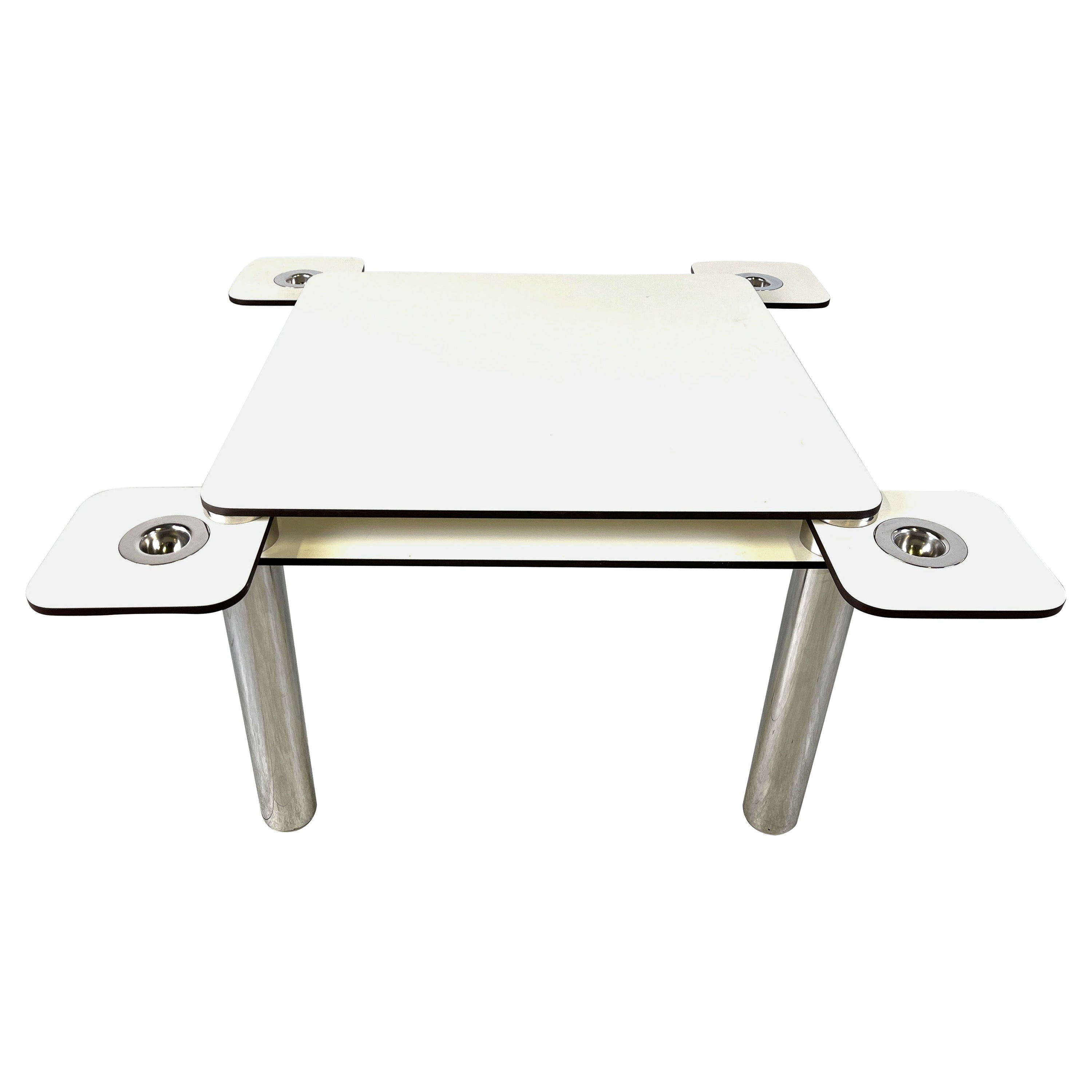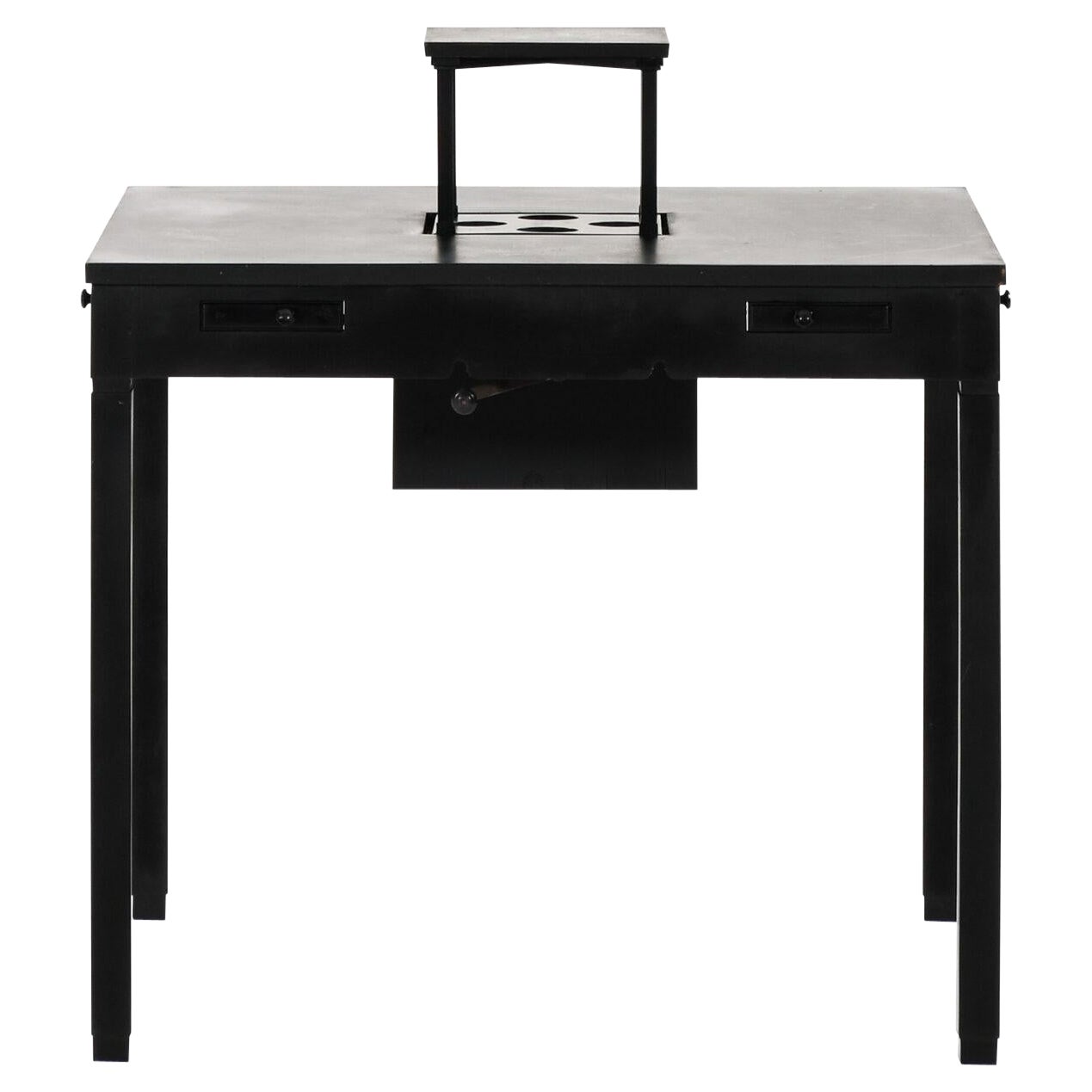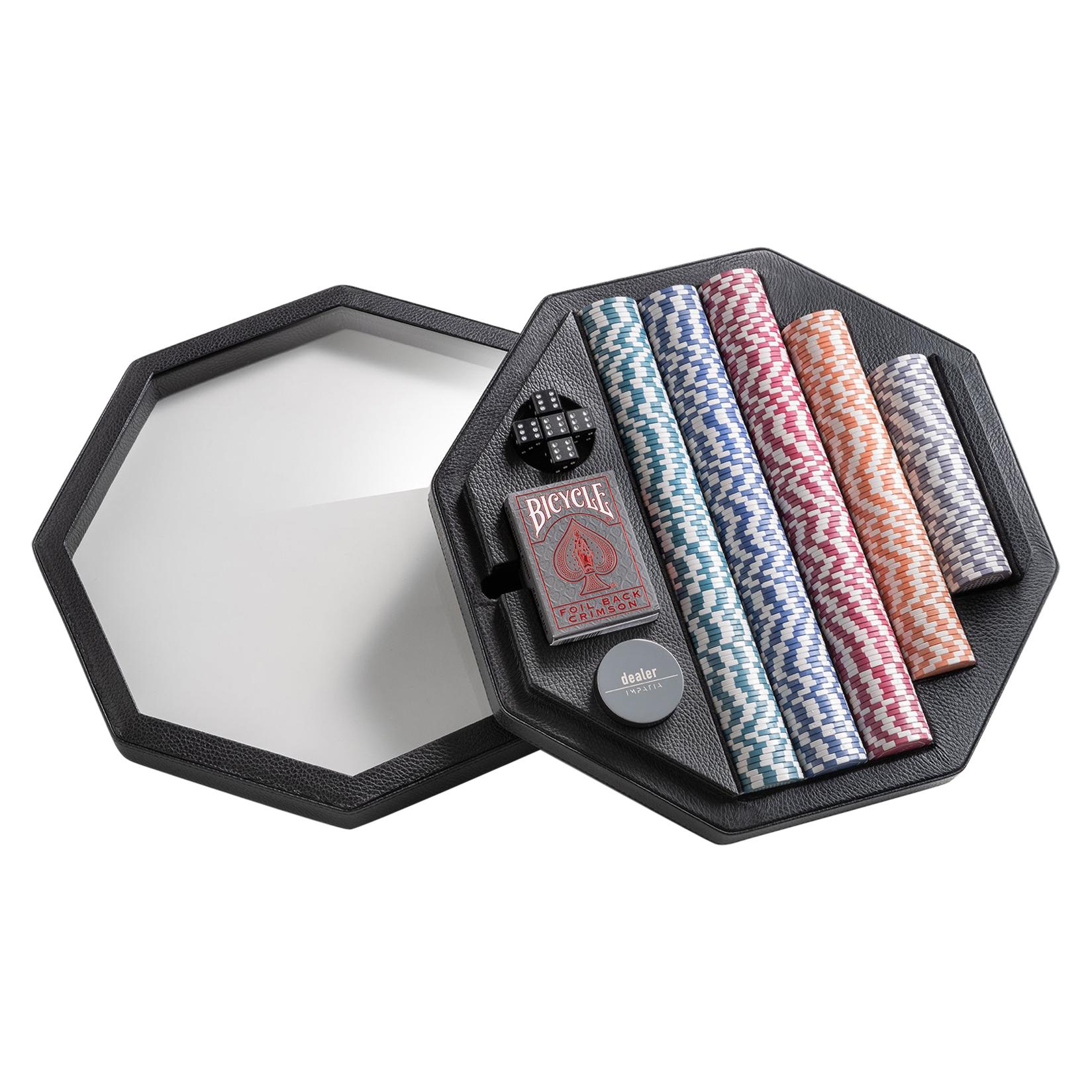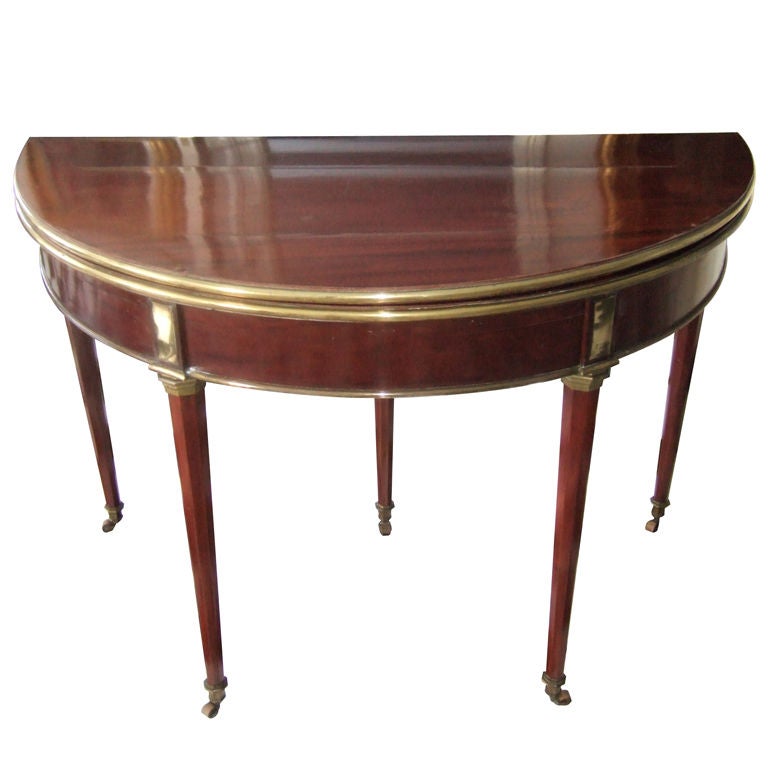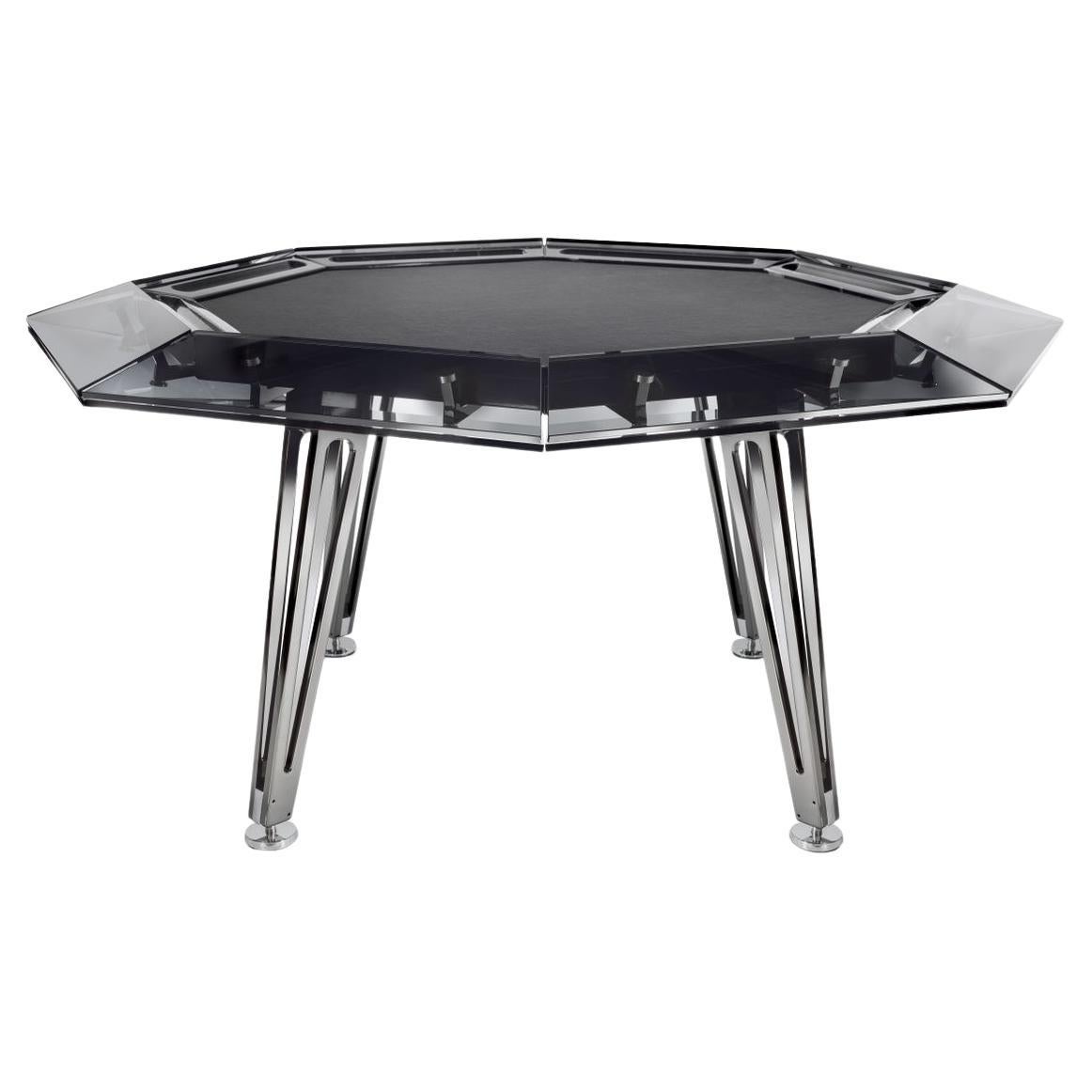Joe Colombo Poker Game Table
About the Item
- Creator:Joe Colombo (Designer)
- Dimensions:Height: 27.56 in (70 cm)Width: 51.58 in (131 cm)Depth: 51.58 in (131 cm)
- Materials and Techniques:
- Period:
- Date of Manufacture:1968
- Condition:Wear consistent with age and use.
- Seller Location:Milan, IT
- Reference Number:1stDibs: LU5918237131982
Joe Colombo
He died tragically young, and his career as a designer lasted little more than 10 years. But through the 1960s, Joe Colombo proved himself one of the field’s most provocative and original thinkers, and he produced a remarkably large array of innovative furniture, lighting and product designs. Even today, the creations of Joe Colombo have the power to surprise.
Cesare “Joe” Colombo was born in Milan, the son of an electrical-components manufacturer. He was a creative child — he loved to build huge structures from Meccano pieces — and in college he studied painting and sculpture before switching to architecture. In the early 1950s, Colombo made and exhibited paintings and sculptures as part of an art movement that responded to the new Nuclear Age, and futuristic thinking would inform his entire career. He took up design not long after his father fell ill in 1958, and he and his brother, Gianni, were called upon to run the family company. Colombo expanded the business to include the making of plastics — a primary material in almost all his later designs. One of his first, made in collaboration with his brother, was the Acrilica table lamp (1962), composed of a wave-shaped piece of clear acrylic resin that diffused light cast by a bulb concealed in the lamp’s metal base. A year later, Colombo produced his best-known furniture design, the Elda armchair (1963): a modernist wingback chair with a womb-like plastic frame upholstered in thick leather pads.
Portability and adaptability were keynotes of many Colombo designs, made for a more mobile society in which people would take their living environments with them. One of his most striking pieces is the Tube chair (1969). It comprises four foam-padded plastic cylinders that fit inside one another. The components, which are held together by metal clips, can be configured in a variety of seating shapes. Tube chairs generally sell for about $9,000 in good condition; Elda chairs for about $7,000. A small Colombo design such as the plastic Boby trolley — an office organizer on wheels, designed in 1970 — is priced in the range of $700. As Colombo intended, his designs are best suited to a modern decor. As you see on 1stDibs, if your tastes run to sleek, glossy Space Age looks, the work of Joe Colombo offers you a myriad of choices.

- ShippingRetrieving quote...Ships From: Milan, Italy
- Return PolicyA return for this item may be initiated within 14 days of delivery.
- 18th Century, Venice, Walnut Wood TableLocated in Milan, ITVenice, 18th century Coffee table Walnut wood, cm 76 x 73 x 53 Small and refined this elegant coffee table in walnut wood has a small central drawer and is finely carved with ...Category
Antique 18th Century Italian Tables
MaterialsWood, Walnut
- France, circa 1810 -1820 Table Clock with a Handmaid Mercury Gilded BronzeLocated in Milan, ITFrance, circa 1810 -1820 Table clock with a handmaid Mercury gilded bronze, alt. cm 59.5 x 40.5 x 13 Signed in the quadrant "Sezille Palais Royal Nº 133 à Paris" Akin to the prevailing taste of the Napoleonic era that envisaged a return to antiquity, the Empire Style was used for the decoration of furniture, architectural structures, furnishings, wall hangings and fabrics. The style envisaged a classical return to order, embellished by the antiquarian whimsy inspired by the recent archaeological discoveries at Herculaneum and Pompeii: the constant Roman and Hellenistic remembrance was celebrated through applications depicting laurel or oak garlands, imperial symbolism, mythological figures, sphinxes, muses, personifications and more. This watch organises the mechanical case on a parallelepiped supporting structure, subdivided into two parts connected by a sinuous greek decoration with flowers; the whole structure rests on the plane by means of convex feet decorated with a dense network of small flowers inscribed within a modular rhombus, culminating, in the attachment to the central body of the watch, with a theory of palmettes. The upper part of the parallelepiped body, inscribed with mythological figuration like the ancient stelae, encloses the latter with a frame of stylised palm leaves interspersed with discs of flowers, in turn accompanied, on the two vertical sides, by a lively vegetal triumph. Considering the iconographic range used by the bronzeworkers for the decoration of the clocks, it is possible to recognise in the mythological scene depicted the muse of poetry and music, Calliope, accompanied by the attributes of the lyre and the laurel branch, used to pay homage to poets. The two winged geniuses in front of her carry scrolls and plates on which to engrave the verses the muse dictates daily to men; the reward for human intellect is emphasised by the two similar crowns the muse holds in her hands, depicting a serpent biting its tail. This symbol, which the mediaeval era would borrow from the Hellenistic-Roman environment of Gnosticism by creating the figure of the uroboros, metaphorically manifests the purpose of the clock, being used to personify the eternal return of time and the cyclical nature of the material life of men. The case of the watch is enclosed in a zither, which is flanked by a woman crowned with laurel; the upper part has two griffin heads in correspondence with the arms of the zither, and a second female face crowned with a ring of petals/rays, again alluding to the sublime elevation of poetry. On the right side of the instrument rests a lighted torch accompanied by an extinguished upside-down torch, an allusion to present well-being, victorious over the failings of life, to which the bust of a philosopher in a disc also alludes. The dial has a porcelain ring while the hands are Breuguet. Mechanism with "anchor" escapement with silk-wire pendulum and chime...Category
Antique 1810s French Table Clocks and Desk Clocks
MaterialsBronze
- Vicenza, pair of wooden half-moon bedside tables, late 18th centuryLocated in Milan, ITVicenza, late 18th century Pair of half-moon nightstands (2) cherry wood, 71 x 61 x 27 cm The pair of bedside tables under consideration, with its characteristic crescent shape, i...Category
Antique Late 18th Century Night Stands
MaterialsWood
- 19th Century Pair of Desks with portraits of Petrarch and Leonardo AlabasterLocated in Milan, IT19th century Pair of desks with portraits of Petrarch and Leonardo (2) Alabaster, 34 and 35 cm diam The pair of alabaster discs features a central cameo with the effigy of Petrarch and Leonardo, probably part of a larger series that featured illustrious characters from Italian history. On the openwork frame of Petrarch there are portraits of some characters who face each other, combined for centuries, as can be seen from the shapes of the garments that span several centuries: from the thirteenth century, in which men wear long-tipped bonnets, to the fifteenth century and Sixteenth century, the two characters at the top, in the seventeenth century, with wide collars, up to the eighteenth century. Francesco Petrarca (1304-1374) embodies the figure of the humanist intellectual par excellence, entirely dedicated to the study of Latin conceived as the only form of expression worthy of a man of letters, so as to serve any form of written communication, including letters and the reflection on himself witnessed in the Secretum. A personality made more complex by obsessive perfectionism, which led him to a continuous and infinite editing of the work which he also flaunted to consider as minor and which instead ensured him an undying fame among posterity, the Canzoniere. But the only aspect fixed in the collective imagination is that of the lover who idolizes the places where his ideal love blossomed...Category
Antique 19th Century Italian Abstract Sculptures
MaterialsAlabaster
- 19th Century Views of Pompeii Paintings Tempera on Paper by FergolaLocated in Milan, ITFrancesco Fergola (Naples, 1801 - there, 1875) Pair of Views of Pompeii Tempera on paper, 33 x 48 cm Frame 49 x 64 cm The two views in question are signed by Francesco F...Category
Antique 19th Century Italian Paintings
MaterialsPaper
- 17th Century Virgin of the Assumption Painting Oil on CanvasLocated in Milan, IT17th century Virgin of the Assumption Oil on canvas, 93 x 81 cm Frame, 110 x 97 cm The present Assumption of the Virgin welcomes an innova...Category
Antique 17th Century Italian Paintings
MaterialsCanvas
- Game Table by Joe Colombo for Zanotta, 1970sBy Joe Colombo, ZanottaLocated in HEVERLEE, BEJoe Colombo (Milan 1930 - 1971) "Poker" card table Laminate, stainless steel, Game table designed in 1968 by the famous designer Joe Colombo, produced by Zanotta, with double layered...Category
Vintage 1970s Italian Post-Modern Game Tables
MaterialsChrome
- Game- / Poker Table Produced in SwedenLocated in Limhamn, Skåne länRare game / poker table by unknown designer. Produced in Sweden.Category
Vintage 1930s Swedish Scandinavian Modern Game Tables
MaterialsWood, Lacquer
- Unootto Game Set for Unootto Poker Table by ImpatiaBy IMPATIALocated in Beverly Hills, CAAbout Impatia: At Impatia each creation is a tale of excellence, driven by the core value of empathy. The human-to-human approach creates a journey of exploration, which is highlighted by technical development, high-quality materials and incomparable aesthetic refinement. The development of each product is full of interpretation from the first glance, becoming a representation of a lifestyle and an instantly recognizable identity, that pushes to reinvent the classics. About the Unootto collection: Unootto is the reinterpretation of the traditional professional poker table, making the A-game stylish and sophisticated. The entire structure is made of glass and is inspired by the Classic cut of the diamond. The octagonal table consists of a frame that supports the playing surface in Alca- ntara®. The chrome finish metal legs make this jewel of an Italian design even more brilliant. A table with outstanding design and functionality, the Unootto steps up the game of poker with its stylish appearance. Featuring a medley of luxury materials, which are handcrafted by only the best. This listing only includes Poker Game Set...Category
2010s Italian Game Tables
MaterialsLeather, Glass
- Custom Poker Game Set With Leather Box by ImpatiaBy IMPATIALocated in Milan, ITWith each collection, Impatia aims to explore design through different perspectives. Among a strong focus on developing one of kind game tables, it is just as equally important to fo...Category
2010s Italian Modern Games
MaterialsChrome
- Game TableLocated in New York, NYA french game table in mahogany decorated with brass detailing.Category
Antique 18th Century and Earlier French Game Tables
MaterialsBrass
- Unootto Black 8 Players Poker TableBy IMPATIALocated in Beverly Hills, CAImpatia, an Italian luxury design company founded by architect Gregg Brodarick in 2012, specializes in customizing all kinds of luxury gaming tables for customers. Impatia reinterprets high-quality leisure life with iconic and avant-garde designs, bringing classic games to life, and introducing a recognizable new luxury lifestyle to the world. The refined lines of the Unootto poker table...Category
21st Century and Contemporary Italian Game Tables
MaterialsMarble, Metal
